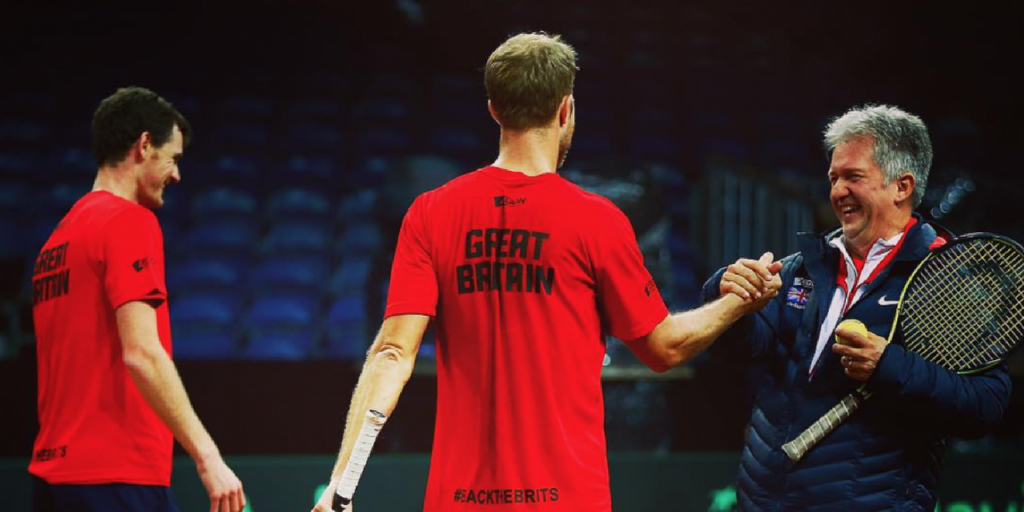Widely acknowledged as the world’s preeminent doubles coach, Louis Cayer (Kai-EH) is, in street lingo, “da man” of the four-player game. Currently, he’s head of doubles for Great Britain’s Lawn Tennis Association, and coaches
Jamie Murray of Great Britain and his Brazilian partner
Bruno Soares (at this writing ranked #7 and #8 in doubles by the ATP, and as high as #1 and #2 last year). Cayer has mentored many of the world’s best players, including six #1-ranked doubles specialists and 24 who’ve reached the ATP top 50. Since 2007, he has coached British Davis Cup and Federation Cup teams, winning the Davis Cup in 2015. Prior to that, he spent 12 years on Canada’s Davis Cup squads.
Universal Tennis (UTR) has recently launched its
new doubles rating, so it’s a good time to explore the art of doubles with its reigning maestro. We caught up with Cayer in Melbourne, Australia, where he was with his athletes at the Australian Open.
“My philosophy of doubles is that it is less about winning points than making your opponents miss,” Cayer says. “Not so much hitting aces and winning returns, or being ‘amazing.’ You want to make the opponents play badly. You do that by creating uncertainty and anxiety. They start trying to hit harder and closer to the lines. Anxiety increases muscle tension, and they begin to play poorly.”
Cayer also endorses the
level-based play at the core of UTR’s mission. “Almost every federation in the world is built on participation,” he says. “We need more people playing the game—there are so many other things they can do! If
can make setting up good matches easier, that’s great. Take a game like chess: you must have a good rating system to have good games. Your rating goes up when you beat someone with a higher rating. In tennis, the French classification system has also worked quite well.”
 French, in fact, is Cayer’s first language; he was born in Montreal in 1952. “When I was 16, I had a summer job unloading a truck at a hospital,” he recalls. “Across the street there was a park with tennis courts and lessons going on. I thought it would probably be more fun to teach tennis than unload trucks.”
At 18, Cayer won a tournament for tennis teachers and was invited to join an elite group of coaches in Montreal. “I was always teaching tennis. Nights and weekends,” he says. “I would not even have my lunch.” As a young coach, Cayer spent six to seven months on the road each year, then taught other tennis coaches for three or four months. He became head coach at the Nuns’ Island Tennis Club in Montreal, the largest club in Canada, with 20 indoor courts. Cayer launched a very successful junior program there.
In 1989, Pierre Lamarche, then captain of Canada’s Davis Cup team, invited Cayer to become his assistant, and four years later, Cayer was promoted to captain himself. His Canadian doubles teams excelled, frequently ranking among the world’s top five. “I was quickly labeled a doubles specialist,” he says. “I had that sticker placed on my forehead.”
French, in fact, is Cayer’s first language; he was born in Montreal in 1952. “When I was 16, I had a summer job unloading a truck at a hospital,” he recalls. “Across the street there was a park with tennis courts and lessons going on. I thought it would probably be more fun to teach tennis than unload trucks.”
At 18, Cayer won a tournament for tennis teachers and was invited to join an elite group of coaches in Montreal. “I was always teaching tennis. Nights and weekends,” he says. “I would not even have my lunch.” As a young coach, Cayer spent six to seven months on the road each year, then taught other tennis coaches for three or four months. He became head coach at the Nuns’ Island Tennis Club in Montreal, the largest club in Canada, with 20 indoor courts. Cayer launched a very successful junior program there.
In 1989, Pierre Lamarche, then captain of Canada’s Davis Cup team, invited Cayer to become his assistant, and four years later, Cayer was promoted to captain himself. His Canadian doubles teams excelled, frequently ranking among the world’s top five. “I was quickly labeled a doubles specialist,” he says. “I had that sticker placed on my forehead.”
“I love the challenge. Doubles is complex. It’s like coaching three players: the deuce-court player, the ad-court player, and the team.”
Cayer’s precise grasp of space, angles, and the geometric aspects of doubles is unmatched; call him the Archimedes of the alleys. He uses long ropes stretched across the court, for example, to show how a net player’s area of coverage changes when his or her partner serves wide, versus up the middle. He sometimes seats net players on folding chairs placed on the centerline to illustrate how many balls they can volley even without moving their feet. “I’m most picky about positioning and movement—where the two players place themselves individually, and as a team,” Cayer says. “I love the challenge. Doubles is complex. It’s like coaching three players: the deuce-court player, the ad-court player, and the team.”
Cayer observes that the ATP “should do something to upgrade the visibility of doubles.” (Doubles specialist Eric Butorac, who was coached by Cayer, made efforts in this direction as president of the ATP Player Council.) At this year’s Australian Open, the men’s doubles winners, Henri Kontinen of Finland and Australian John Peers, received prize money equal to 16 percent of what Roger Federer gained by winning the men’s singles.
Over 30 years of working with the pros, Cayer has watched the doubles game evolve. “The game has become very powerful,” he says. “Until the end of the 1990s, doubles was played the same way for years: a lot of serve-and-volley, and chip-and-charge. Today you see very few chip or lob returns—instead, lots of power returns. Thirty percent of the time now, the men serve and stay back to rip their forehands. The receiving team may have a player at mid-court or both players back.”
Earlier in his career, Cayer coached singles and also club players—at Nuns' Island, for example—and of course, there are differences. “Professionals will disguise their lobs,” he notes, “whereas club players don’t disguise them.” Age also affects tactics. “When I was 20, I’d play two meters from the net,” he says. “Now I’m 64, so I play three meters back; it’s easier to move forward to intercept a slow ball than to move back fast enough to cross the service line before the lob does—which is what you want to do!”
Raise two glasses to celebrate UTR’s new doubles ratings—available here.
Universal Tennis (UTR) has recently launched its new doubles rating.
 French, in fact, is Cayer’s first language; he was born in Montreal in 1952. “When I was 16, I had a summer job unloading a truck at a hospital,” he recalls. “Across the street there was a park with tennis courts and lessons going on. I thought it would probably be more fun to teach tennis than unload trucks.”
At 18, Cayer won a tournament for tennis teachers and was invited to join an elite group of coaches in Montreal. “I was always teaching tennis. Nights and weekends,” he says. “I would not even have my lunch.” As a young coach, Cayer spent six to seven months on the road each year, then taught other tennis coaches for three or four months. He became head coach at the Nuns’ Island Tennis Club in Montreal, the largest club in Canada, with 20 indoor courts. Cayer launched a very successful junior program there.
In 1989, Pierre Lamarche, then captain of Canada’s Davis Cup team, invited Cayer to become his assistant, and four years later, Cayer was promoted to captain himself. His Canadian doubles teams excelled, frequently ranking among the world’s top five. “I was quickly labeled a doubles specialist,” he says. “I had that sticker placed on my forehead.”
French, in fact, is Cayer’s first language; he was born in Montreal in 1952. “When I was 16, I had a summer job unloading a truck at a hospital,” he recalls. “Across the street there was a park with tennis courts and lessons going on. I thought it would probably be more fun to teach tennis than unload trucks.”
At 18, Cayer won a tournament for tennis teachers and was invited to join an elite group of coaches in Montreal. “I was always teaching tennis. Nights and weekends,” he says. “I would not even have my lunch.” As a young coach, Cayer spent six to seven months on the road each year, then taught other tennis coaches for three or four months. He became head coach at the Nuns’ Island Tennis Club in Montreal, the largest club in Canada, with 20 indoor courts. Cayer launched a very successful junior program there.
In 1989, Pierre Lamarche, then captain of Canada’s Davis Cup team, invited Cayer to become his assistant, and four years later, Cayer was promoted to captain himself. His Canadian doubles teams excelled, frequently ranking among the world’s top five. “I was quickly labeled a doubles specialist,” he says. “I had that sticker placed on my forehead.”


